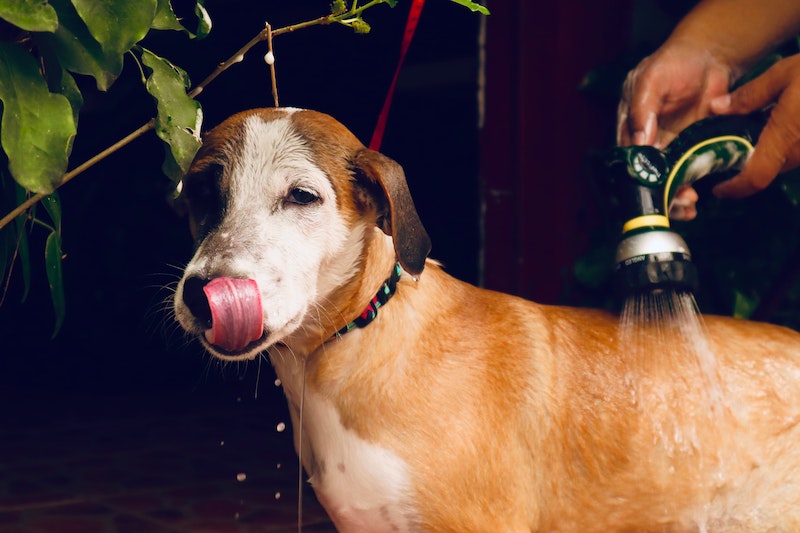The Ultimate Guide to Hiking with Your Dog
Follow these ‘Leave No Trace’ principles to protect your dog, and Mother Nature, when you hit the trail.

Follow these ‘Leave No Trace’ principles to protect your dog, and Mother Nature, when you hit the trail.

The great outdoors are calling, and there’s no better hiking companion than your canine! But hiking with your pet requires a little extra preparation to keep them happy and healthy along the trail, and to respect the environment around you.
Let’s take a look at the best practices for hiking with your pup.
This concept encourages outdoor enthusiasts to enjoy time outdoors while minimizing their impact. The goal is essentially to preserve the integrity and beauty of nature by refraining from leaving any kind of waste or traces of human or pet activity.
When hiking with your dog, leaving no trace means following specific practices to keep nature pristine and beautiful—not just for the local wildlife, but also for other hikers who share the trails with you and your four-legged companion.

Preparation is key to any hiking adventure, and when you’re bringing along your fur fam, there are some extra measures you should take to help set them up for success.
Schedule a visit with your vet to make sure your dog is physically fit for hiking. Ask about any vaccines or other preventative measures they might need, especially if you plan to hike in areas where ticks or other parasites are common.
Hiking is a strenuous activity for our four-legged friends. Create an exercise schedule to physically prepare them for the outdoor excursions. Gradually progress daily walks to longer sessions and more challenging terrains. Consistency is key to build up their stamina and adaptability.
If you plan for your pooch to wear a dog backpack to carry their own gear on the trail, include it in their training. First, get them used to wearing the pack, then gradually add weight to it. As a rule of thumb, a healthy dog can carry about 10-12% of their body weight.
These walks are also an important time to work on your pooch’s manners. Make sure your dog walks well on a leash and respects basic commands like—like sit, stay, and come.
Acclimate your dog to different environments, humans, and animals to help prevent excessive barking, becoming aggressive towards other animals or people, and other disruptive behaviors like digging.
It’s crucial to select a trail that is both dog-friendly and aligned with your dog’s physical abilities.
Look for hiking trails that allow dogs, and read up on leash regulations. For example, you can check out which National Parks allow dogs here, and search dog-friendly hikes in your area using websites like BringFido.
Consider a hike’s length, intensity, and the temperature outside to make sure it’s something your dog can handle (and enjoy).
It probably wouldn’t be a good idea to take your dog that’s used to a flat 1-mile loop on a high altitude 10-mile excursion with lots of scrambling up a mountain. Not only could it be dangerous for your dog, but it could also make for an even more difficult hike for you if you have to push or carry your dog over rough terrain.
Packing the right hiking gear is key to having a safe and fun outdoor adventure with your dog.
Here’s our recommended packing list of what to include in you or your pup’s pack:
During the hotter months, it’s even more important to take extra precautions to protect your pooch from the summer heat. As temperatures rise, look for signs of heat stroke and consider packing additional gear like:

Once you reach the trailhead, it’s important for both you and your four-legged hiking buddy to follow trail etiquette to respect the environment and other hikers.
For example, the National Park Service recommends that dog owners help their pup’s learn the B.A.R.K. principles, which include:
Stick to marked trails to minimize environmental damage. Letting your dog roam off-trail could also expose your dog to hidden dangers like poisonous plants or hidden holes.
If you’re hiking in the backcountry where pets are permitted, make sure to follow all posted regulations and guidelines for pet safety and environmental preservation.
It can be unpredictable how your pooch might react to wildlife, or an aggressive dog. Even if your dog is trained and well-behaved enough to go off-leash, respect leash laws by keeping your dog on a short leash, especially when passing other hikers or animals.
Always bring plenty of biodegradable poop bags to pick up after your dog, and carry out all of your dog’s waste until you reach a designated garbage or pet waste disposal bin.
Now, when it comes to your pup’s pee, encourage your dog to do their business at least 200 feet away from water sources, off the direct walking path, and somewhere with sparse vegetation.
The trail isn’t just for humans and pets to enjoy, it’s home to a diversity of wildlife. Excessive barking can disturb local wildlife’s natural behaviors and add stress. It could even provoke attention from wild animals, potentially leading to a dangerous encounter.
Training your dog to respond to “quiet” commands, and offering them toys or treats to distract them from potential triggers, can help maintain harmony with your natural surroundings.
That cool stick your dog found? As tempting as it may be, leave natural objects as you found them.
Taking sticks, stones, or other parts of nature from their home disrupts the local ecosystem and can affect both plant and animal life. Plus, these objects are part of the beauty of the trail, so they’re best left untouched for future trail goers to appreciate.
Training your pup to respond to commands like “leave it” and “drop it”, and diverting their attention with toys and treats can help keep nature as it was.

You’ll likely encounter some flora and fauna along your journey. Let’s explore how to navigate the trail’s natural elements respectfully and safely.
Ingesting, or even touching, certain plants could lead to uncomfortable if not dangerous reactions in your dog. Follow these steps to help prevent any harm to your dog from plants:
If you notice your dog experiencing foaming at the mouth, vomiting or diarrhea, difficulty breathing, seizures, or skin irritation—seek treatment immediately.
Always ask for permission before letting your dog approach another hiker or their pet. Not all dogs are friendly or react well to strangers.
From squirrels and rabbits to bears and snakes, make sure you know what types of wildlife you might encounter on your hike. Keeping your dog on a leash is usually the best way to control unexpected situations.
Hiking in snake country? Learn more about what to do if your pooch is bitten by a snake, and consider snake training your dog.

After a day of hiking, your pup deserves some recovery and TLC.
Here are some best practices:
Keep an eye on your dog for any signs of excessive fatigue, discomfort, or changes in behavior after a hike. If anything seems off, a vet visit may be necessary.
Even the most well-prepared pet parents and hikers can encounter an unexpected misadventure along the trail. That’s where pet insurance can be a lifesaver.
A base Lemonade Pet policy can help take a bite out of medical expenses for diagnostics and treatments related to accidents and illnesses (provided those occur after your policy’s waiting period has ended) including hike-related mishaps.
Plus, you can easily customize your pup’s policy with our preventative care packages and optional add-ons to meet the unique needs of your pup, and your wallet.
Click below to get your quote started. Happy trails!
A few quick words, because we <3 our lawyers: This post is general in nature, and any statement in it doesn’t alter the terms, conditions, exclusions, or limitations of policies issued by Lemonade, which differ according to your state of residence. You’re encouraged to discuss your specific circumstances with your own professional advisors. The purpose of this post is merely to provide you with info and insights you can use to make such discussions more productive! Naturally, all comments by, or references to, third parties represent their own views, and Lemonade assumes no responsibility for them. Coverage and discounts may not be available in all states.
Please note: Lemonade articles and other editorial content are meant for educational purposes only, and should not be relied upon instead of professional legal, insurance or financial advice. The content of these educational articles does not alter the terms, conditions, exclusions, or limitations of policies issued by Lemonade, which differ according to your state of residence. While we regularly review previously published content to ensure it is accurate and up-to-date, there may be instances in which legal conditions or policy details have changed since publication. Any hypothetical examples used in Lemonade editorial content are purely expositional. Hypothetical examples do not alter or bind Lemonade to any application of your insurance policy to the particular facts and circumstances of any actual claim.